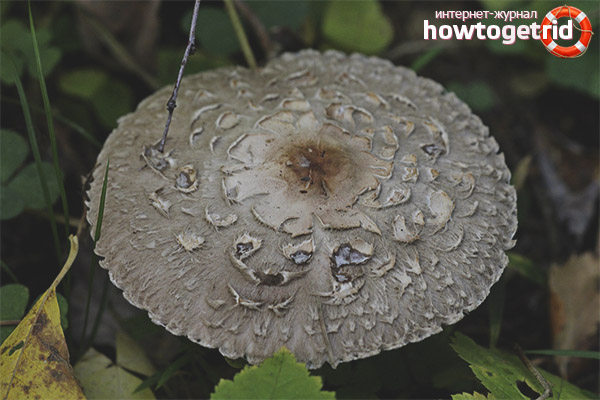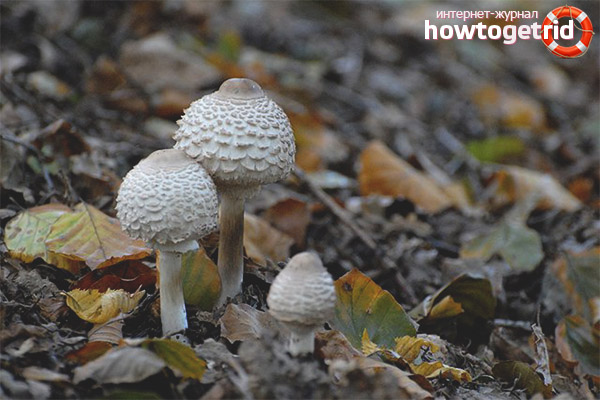The content of the article
Red umbrella (Macrolepiota rhacodes) is an edible mushroom, which is still little known. Belongs to the family Champignon. Its other name is Coop. This name he received because in the fried form resembles chicken meat. Also found the name Shaggy Umbrella - this is because of the appearance of the fungus, it is all as if in tatters.
Where can I meet?
He prefers a temperate climate, soil with humus and open spaces. It is found on glades, glades and even in parks. Very widespread, growing on almost all continents. Fruit bodies form groups, one rarely occurs. Mushrooms appear from the beginning of summer and grow until late autumn.
Appearance Description
Umbrella reddening has the following distinctive features:
- The hat is light, closer to the top is colored brown or brown. On it are characteristic scales. They are rather large and painted in a pinkish or grayish color. These scales and make mushroom shaggy. In young mushrooms, the cap is spherical, and with age it straightens to flat. The edge often cracks. In the middle of the cap there is a dark brown stain, and scales spread around it. Inside the tender flesh with a pleasant aroma. Immediately after cutting it is white, and then acquires a red-brown shade.
- Leg rounded, medium in thickness. Above, slightly narrowed. On the cut after white, the red-brown color is even more pronounced. The girth of the legs is within 2 cm, and the height is maximum 15 cm. Inside it is hollow, it comes off very easily from the cap. In general, the surface is smooth, but there are some fibers. In young mushrooms, the leg is light, and in the process of aging becomes brownish. Closer to the cap there is a soft ring, similar to a film, having a white color on top and brown on the bottom. Its surface is covered with small scales.
- The plates of the reddening umbrella are arranged freely and have a width of up to 1.5 cm. The plates themselves are white, and the spores that mature in them are also white.
Remarkable facts about the umbrella blushing:
- The legs, as a rule, are not eaten, but due to their bactericidal properties in dried form, they are used to disinfect the space, for example, in an apartment.
- Mushroom pickers reluctantly collect umbrellas because of their similarity to poisonous species. To prepare them, only experienced lovers of "quiet hunting" will cut them off.
Eating
In an umbrella turning red in food, caps are consumed, their flesh is tender and tasty. The legs are too hard, so they are usually left. Before cooking the mushroom, it is necessary to remove the scales from the caps.
Collect mushrooms in a young state, and during cooking a good heat treatment is important. Very small umbrellas are collected for pickling. Older specimens are good for drying, salting and cooking various soups, sauces and stuffing in baking.
They like to collect a reddening umbrella because it contains many vitamins and minerals, it contains tyrosine, melanin and arginine.
This mushroom is also used in traditional medicine. Various tinctures on a reddening umbrella and extracts from it help to fight rheumatism, diseases of the heart and blood vessels, nervous disorders, and even oncology.This mushroom is a dietary product and is approved for use in diabetes. Do not eat it:
- women carrying or nursing a baby;
- at children's age up to 5 years;
- with problems with the stomach or intestines;
- a patient with pancreatitis.
Similar species
The reddening umbrella has similar species both edible and poisonous. Mushroom pickers need to be very careful when collecting it.
Edible mushrooms:
- Girl's umbrella (Leucoagaricus puellaris). Autumn resembles the aforementioned chicken coop, but its hat is lighter in color and at the cut the color of the mushroom changes quite a bit.
- Parasol motley (Macrolepiota procera). The size of this mushroom is larger, that is, the cap exceeds 20 cm in diameter. The cut does not change in color.
- Umbrella thin (Macrolepiota gracilenta). This representative of the form is smaller than the umbrella reddening and when cutting also leaves its color.
- Chlorophyllum is dark brown (Chlorophyllum brunneum). He has a more brown shade of color.On a hat, scales are larger in size than those of a reddening umbrella. On the leg is characteristic for him and quite noticeable thickening.
- Chlorophyllum lead or slag or Morgan's umbrella (Chlorophyllum molybdites). The mushroom is very poisonous and at the same time it looks like an umbrella reddening. The cap varies in size from 10 to 30 cm, white with brown-pink scales. At a young age like a ball, and then opens to a flat state. The leg is also smooth, having a ring at the top. The flesh turns red at the cut, but it does not have a pronounced smell. The fungus is widely distributed in Eurasia, as well as in African countries, in Australia and America. The plates are white, but if pressed on, they turn yellow and sometimes turn brown. In old mushrooms, the plates are greenish, olive-colored.
Video: umbrella reddening (Chlorophyllum rhacodes)













To send